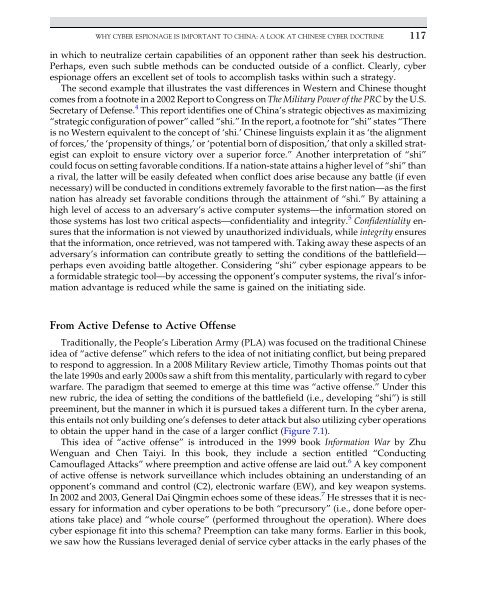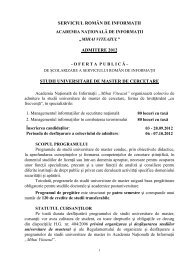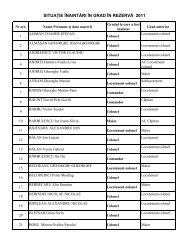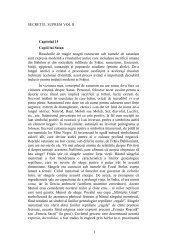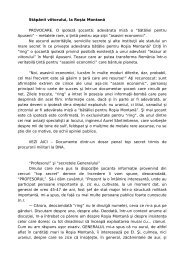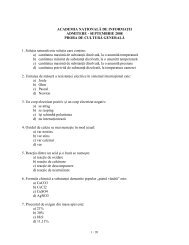Introduction to Cyber-Warfare - Proiect SEMPER FIDELIS
Introduction to Cyber-Warfare - Proiect SEMPER FIDELIS
Introduction to Cyber-Warfare - Proiect SEMPER FIDELIS
You also want an ePaper? Increase the reach of your titles
YUMPU automatically turns print PDFs into web optimized ePapers that Google loves.
WHY CYBER ESPIONAGE IS IMPORTANT TO CHINA: A LOOK AT CHINESE CYBER DOCTRINE117in which <strong>to</strong> neutralize certain capabilities of an opponent rather than seek his destruction.Perhaps, even such subtle methods can be conducted outside of a conflict. Clearly, cyberespionage offers an excellent set of <strong>to</strong>ols <strong>to</strong> accomplish tasks within such a strategy.The second example that illustrates the vast differences in Western and Chinese thoughtcomes from a footnote in a 2002 Report <strong>to</strong> Congress on The Military Power of the PRC by the U.S.Secretary of Defense. 4 This report identifies one of China’s strategic objectives as maximizing“strategic configuration of power” called “shi.” In the report, a footnote for “shi” states “Thereis no Western equivalent <strong>to</strong> the concept of ‘shi.’ Chinese linguists explain it as ‘the alignmen<strong>to</strong>f forces,’ the ‘propensity of things,’ or ‘potential born of disposition,’ that only a skilled strategistcan exploit <strong>to</strong> ensure vic<strong>to</strong>ry over a superior force.” Another interpretation of “shi”could focus on setting favorable conditions. If a nation-state attains a higher level of “shi” thana rival, the latter will be easily defeated when conflict does arise because any battle (if evennecessary) will be conducted in conditions extremely favorable <strong>to</strong> the first nation—as the firstnation has already set favorable conditions through the attainment of “shi.” By attaining ahigh level of access <strong>to</strong> an adversary’s active computer systems—the information s<strong>to</strong>red onthose systems has lost two critical aspects—confidentiality and integrity. 5 Confidentiality ensuresthat the information is not viewed by unauthorized individuals, while integrity ensuresthat the information, once retrieved, was not tampered with. Taking away these aspects of anadversary’s information can contribute greatly <strong>to</strong> setting the conditions of the battlefield—perhaps even avoiding battle al<strong>to</strong>gether. Considering “shi” cyber espionage appears <strong>to</strong> bea formidable strategic <strong>to</strong>ol—by accessing the opponent’s computer systems, the rival’s informationadvantage is reduced while the same is gained on the initiating side.From Active Defense <strong>to</strong> Active OffenseTraditionally, the People’s Liberation Army (PLA) was focused on the traditional Chineseidea of “active defense” which refers <strong>to</strong> the idea of not initiating conflict, but being prepared<strong>to</strong> respond <strong>to</strong> aggression. In a 2008 Military Review article, Timothy Thomas points out thatthe late 1990s and early 2000s saw a shift from this mentality, particularly with regard <strong>to</strong> cyberwarfare. The paradigm that seemed <strong>to</strong> emerge at this time was “active offense.” Under thisnew rubric, the idea of setting the conditions of the battlefield (i.e., developing “shi”) is stillpreeminent, but the manner in which it is pursued takes a different turn. In the cyber arena,this entails not only building one’s defenses <strong>to</strong> deter attack but also utilizing cyber operations<strong>to</strong> obtain the upper hand in the case of a larger conflict (Figure 7.1).This idea of “active offense” is introduced in the 1999 book Information War by ZhuWenguan and Chen Taiyi. In this book, they include a section entitled “ConductingCamouflaged Attacks” where preemption and active offense are laid out. 6 A key componen<strong>to</strong>f active offense is network surveillance which includes obtaining an understanding of anopponent’s command and control (C2), electronic warfare (EW), and key weapon systems.In 2002 and 2003, General Dai Qingmin echoes some of these ideas. 7 He stresses that it is necessaryfor information and cyber operations <strong>to</strong> be both “precursory” (i.e., done before operationstake place) and “whole course” (performed throughout the operation). Where doescyber espionage fit in<strong>to</strong> this schema? Preemption can take many forms. Earlier in this book,we saw how the Russians leveraged denial of service cyber attacks in the early phases of the


